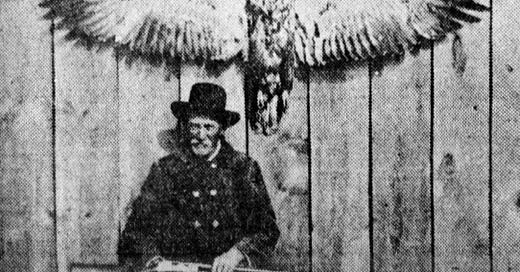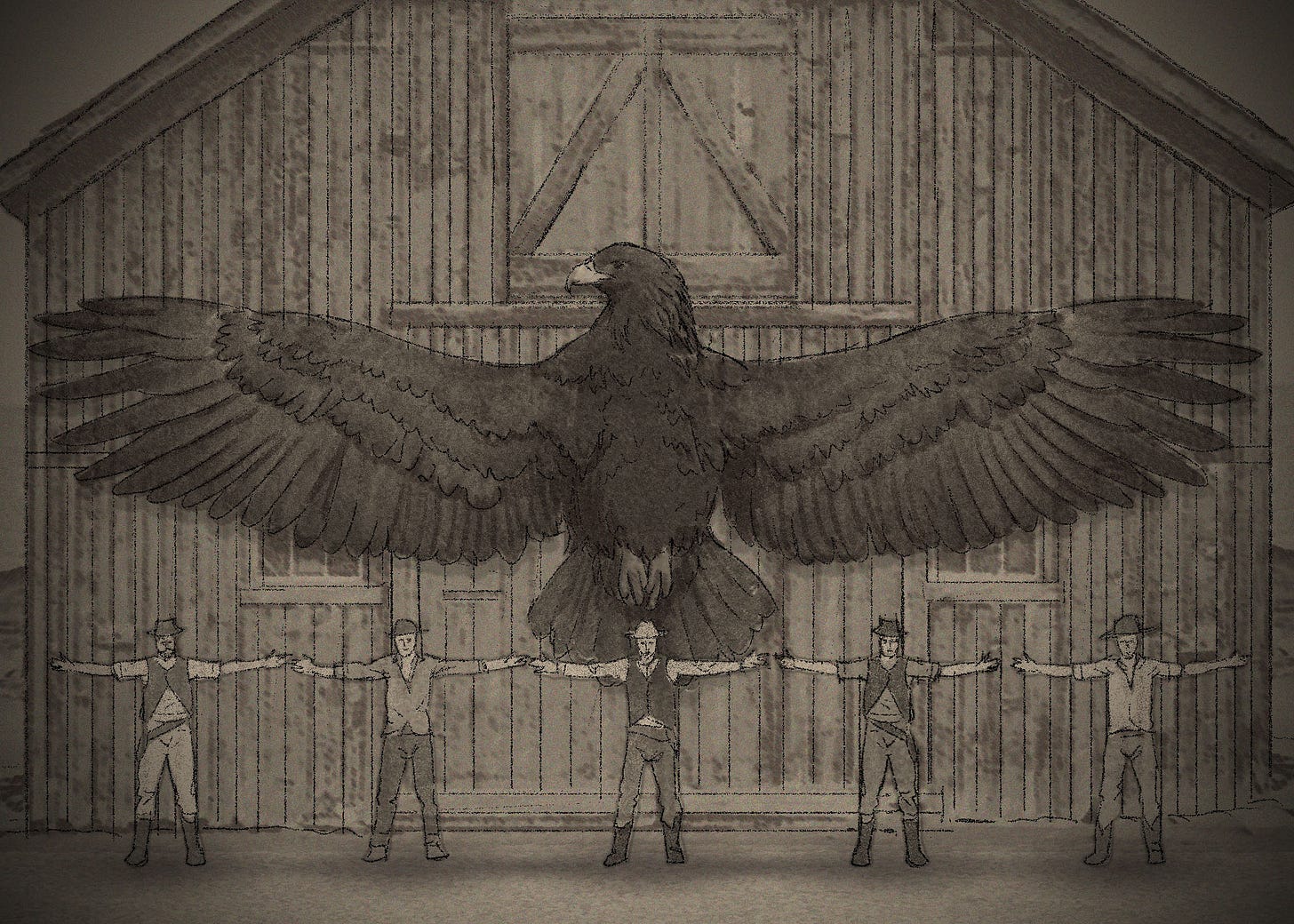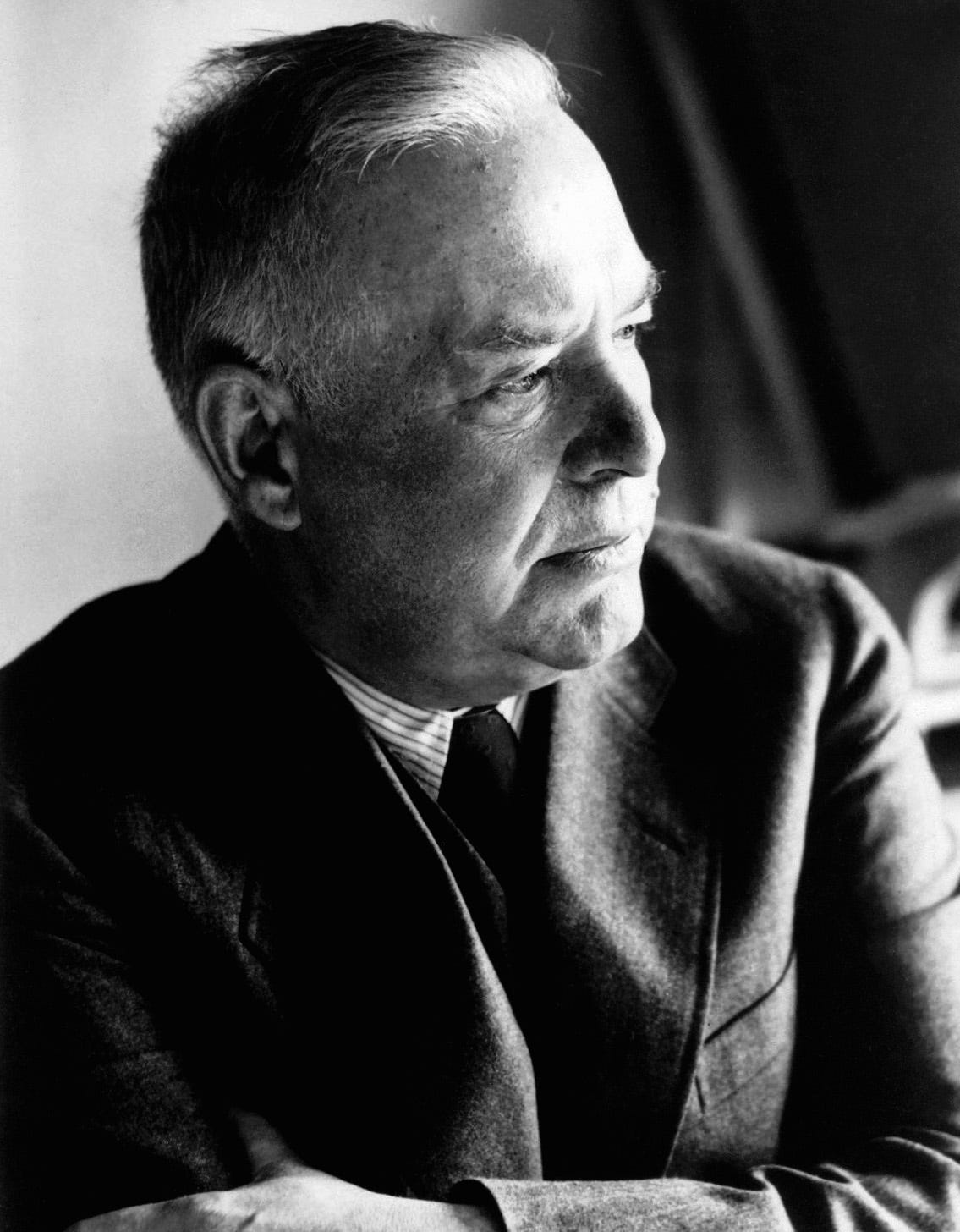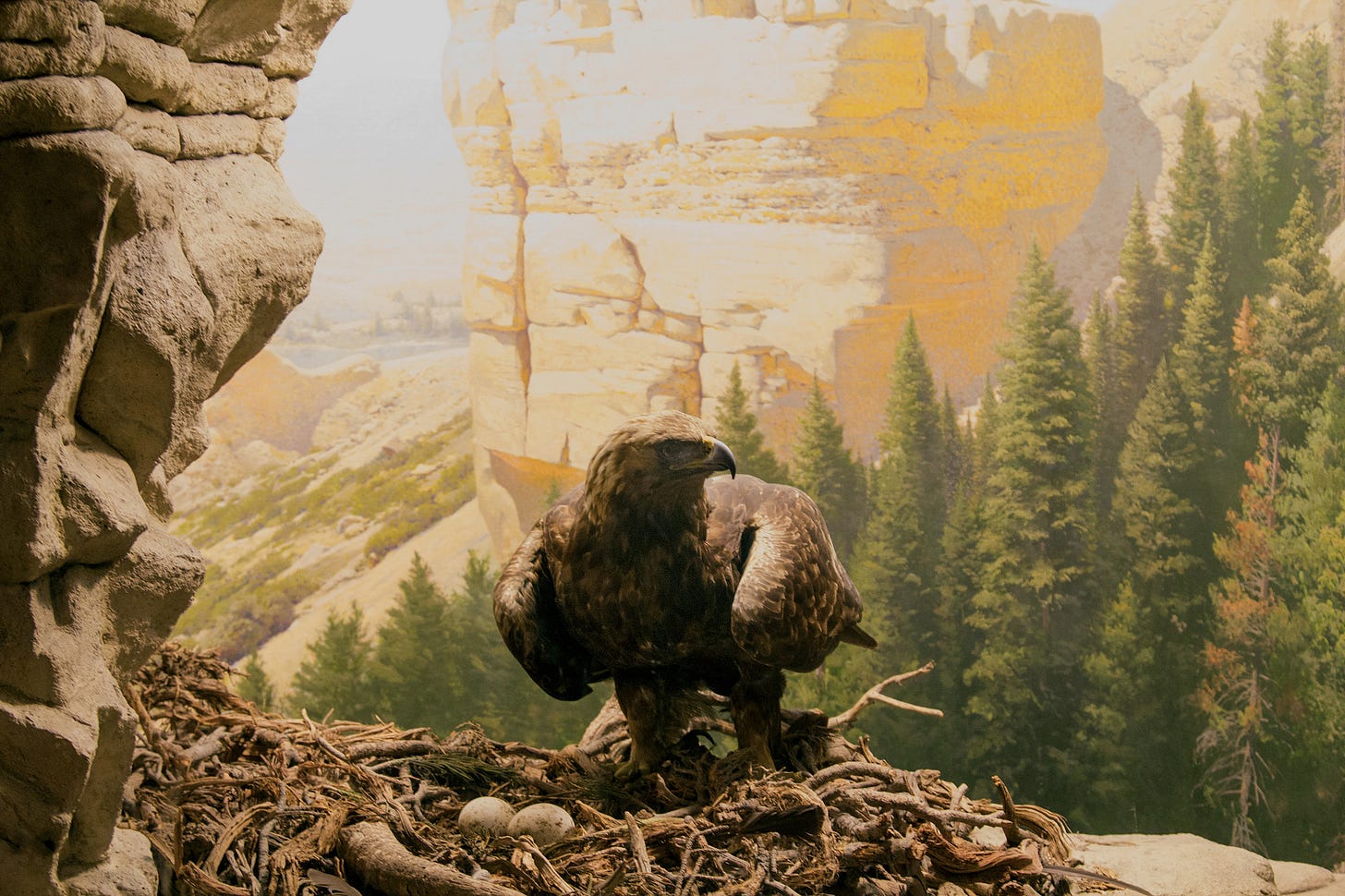A Brief History of Birds Nailed To Barns & the Thunderbird Photo (Part 1)
An enormous bird nailed to a barn wall, several men standing before it, arms outstretched to demonstrate the gargantuan wingspan of their catch—the imagery of the Missing Thunderbird Photo is strange and evocative, alien yet somehow very familiar. While this motif is most associated with the legendary yet elusive photograph, it actually has its roots in a very real, very old tradition. The Thunderbird Photo's iconic scene makes more sense in the context of history and rustic folklore.
First, let's look at a typical description of the Missing Thunderbird Photo. Artist Andrew Minniear, who generously provided an illustration of the elusive photograph based on his memory, described to me the image as he recalls it:
"I was perhaps 4 or 5 years old when I saw the picture. The photo I remember seeing and approximating in my sketch came from a dinosaur book in my elementary school library around 1990 or 1991. I remember that the photograph clearly showed an eagle or otherwise recognizable bird of prey and NOT a pterodactyl as is commonly shown in 'reproductions' of the original photograph. I also clearly remember a line of five or six men dressed in western garb standing in front of the barn wall with their arms outstretched, fingertip to fingertip to demonstrate the measure of the wingspan. I'm confident that the bird was darker than the barn wall in the background. Whether the photo was black and white or sepia toned, I don't really recall. I used a sepia tone in my drawing because I've seen it commonly used in Old West photography. The original photo may have been black and white. I'm confident that the photograph I saw was an image of a gigantic eagle-like raptor, definitely with a hooked beak and most likely with a feathered head and neck. I don't know for sure whether the head was facing left or right, but it was definitely in profile. (My drawing) is, to the best of my knowledge and ability, the most accurate reproduction of the photo I remember seeing."
Minniear's memory is similar to many accounts of the infamous photograph, and his drawing often strikes a chord with those who believe they once saw the photo but cannot find it again today.
An infrequently asked question about this mystery is why the Thunderbird Photo shows what it supposedly does. The answer, as it turns out, lies buried in modern history. A bird nailed to a barn wall might sound strange today but it was once a commonly understood visual. There are hints of this tradition appearing on European farms in past centuries, and ultimately throughout the United States.
Richard Wagner (not, apparently, the famous composer) wrote in 1904, translated from German, that "eagles, falcons, sparrow-hawks, kites, and many others... are all thieves, who rob the farmer of his pigeons and his poultry, and the game-keeper of hares and partridges. They do mischief and damage on all sides, and are consequently hunted down wherever they are to be found." Wagner explained that the common buzzard, not the turkey vulture from North America but the "house hawk" that is native to Europe, was often mistaken for one of these pests due to its similar appearance. This was in spite of the fact that the buzzard is very useful on a farm, consuming approximately 30 corn-munching field mice a day. Wagner wrote that unfortunately for the buzzard, "many farmers and even young sportsmen take him for one of these marauders, shoot him, and nail him up against the barn door."
French painter and etcher Félix Henri Bracquemond etched a depiction of "Birds Nailed to a Barn Door (Le haut d'un battant de porte)" in 1852. It illustrates the practice described by Wagner.
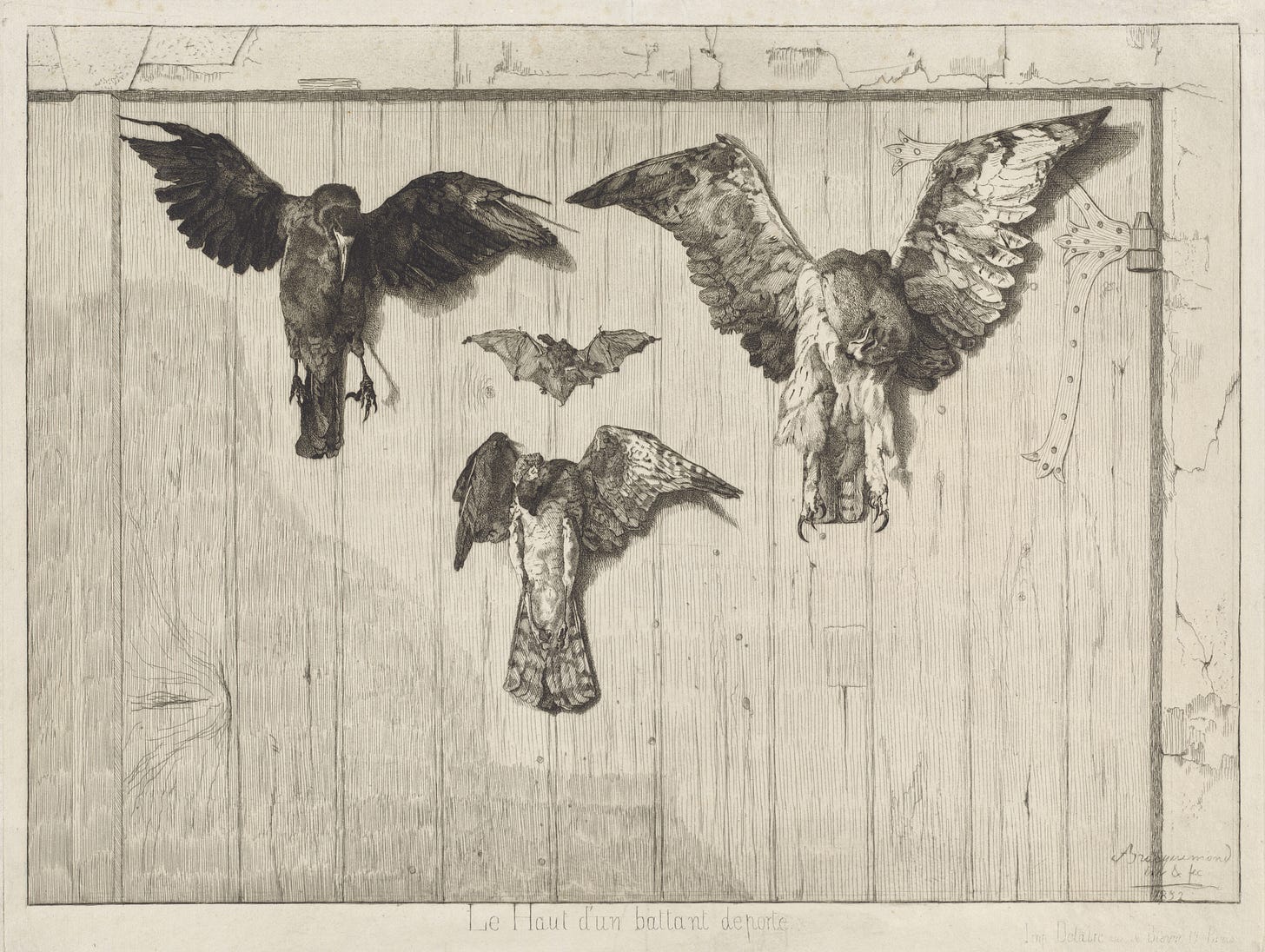
In the United Kingdom, barn owls were subject to a long history of superstitions that persisted until the 1950s. Among these traditions, barn owls would be nailed to barn doors to ward off storms. They would also be skinned and pinned to fire screens, in front of a fireplace, possibly to protect a home's occupants from thunder and lightning. At the risk of forcibly connecting too many dots, it's interesting that this particular superstition involves storms, and that the creature in the mysterious photo has been labeled a "Thunderbird" after the elemental weather being of Native American beliefs.
The European farmer's penchant for nailing up birds as gruesome scarecrows to frighten off their fellows appears to have accompanied settlers as they migrated to America. An 1846 letter in a Boston newspaper noted, "It is said that the sight of a hawk or carrion crow nailed to a barn door has a great effect in keeping such obscene fowl in order..." The writer of a 1909 article in Harper's Weekly compared political assassins to "a flight of crows, sighting the cadaver of a fellow crow, nailed to some barn roof as a warning to other depredators."
"Birds, as a rule, are the farmer's best friends," stated a 1915 newspaper article, published in San Francisco. It decried the ignorance of rural communities that were decimating the populations of birds that might eat their crops, not realizing the greater value of these birds in pest control. "It is proved conclusively that the great majority of birds are more of a help than an injury. It is no uncommon sight, in the country, to see the body of a hawk or a crow nailed to the farmer's barn door, while a mounted owl is often used as a household decoration."
American modernist poet Wallace Stevens included the following lines in his 1937 poem, "The Man With the Blue Guitar":
To nail his thought across the door,
Its wings spread wide to rain and snow...
In a 1940 letter, Stevens explained this reference: "On farms in Pennsylvania a hawk is nailed up, I believe, to frighten off other hawks. Here in New England a bird is more likely to be nailed up merely as an extraordinary object to be exhibited; that is what I had in mind. My stenographer, who was raised on a farm in New England, says that I am wrong about New England, and that it is usually a crow that is nailed up for the purpose of scaring off other crows. But on several occasions I have seen eagles. I feel sure that a farmer would nail up an eagle because it was an eagle."
Stevens essayist Michel Benamou wrote, "The metaphor recalls, of course, the bird nailed by Pennsylvania farmers and French peasants across barn doors, a reference also used by Apollinaire in "Le hibou..." In that 1911 work, French poet Guillaume Apollinaire compared his heart to an owl who has a nail repeatedly driven through it.
Stevens grew up in Reading, Pennsylvania (in Berks County, located in the southeast corner of the state) and spent most of his adult life in Hartford, Connecticut. Take note that many witnesses claim the Thunderbird Photo they remember depicts a giant crow or raven, and many others believe it shows a giant eagle.
"A Guide for Collectors of Oral Traditions and Folk Cultural Material in Pennsylvania," published in 1968, advised, "Folk customs include practices like nailing birds of prey—hawks, for instance, crows, or jays—with outstretched wings to the barn’s gable or the side of a shed, or hanging them from a pole at the periphery of a field to warn others of their kind to stay away; this is still done in Fayette County, throughout the southern United States, and in parts of England."
Colonel Henry W. Shoemaker chronicled northern Pennsylvania traditions about golden eagles in one of his many books about the state's history and folklore. Shoemaker wrote:
"Among the Indians the golden eagle was held in greater reverence than the bald eagle. It was unthinkable to desire the death of the noble bird which they likened in latent powers to the Phoenix of mythology. They believed that it possessed the power to triumph over death, and that it would not allow its lifeless body to remain in the hands of the hunter. They warned the pot-hunters who nailed the limp remains to barn doors, that the familiar spirit of the eagles would petition the Storm God to smite the structure with lightning and carry away the defiled body in the whirl of the tempest. Those who mounted the remains were warned that storms and floods would assail the house where the effigies were kept, overturning them, if necessary, to release the glass-eyed manikins into the gloom of the gale."
Of course, wrote Shoemaker, white hunters chose to ignore this sage advice. According to The Cornell Lab of Ornithology, an adult golden eagle (one of two eagle species that reside in North America, along with the bald eagle) can reach a maximum 7-feet-2-inch wingspan and a weight of 13.5 pounds.
Newspapers in past centuries frequently reported on large eagles shot by hunters, sometimes describing how the fallen raptors were affixed to building walls as trophies. We examine some of these cases in the next installment, as well as digging into the first written account describing the Missing Thunderbird photo…

